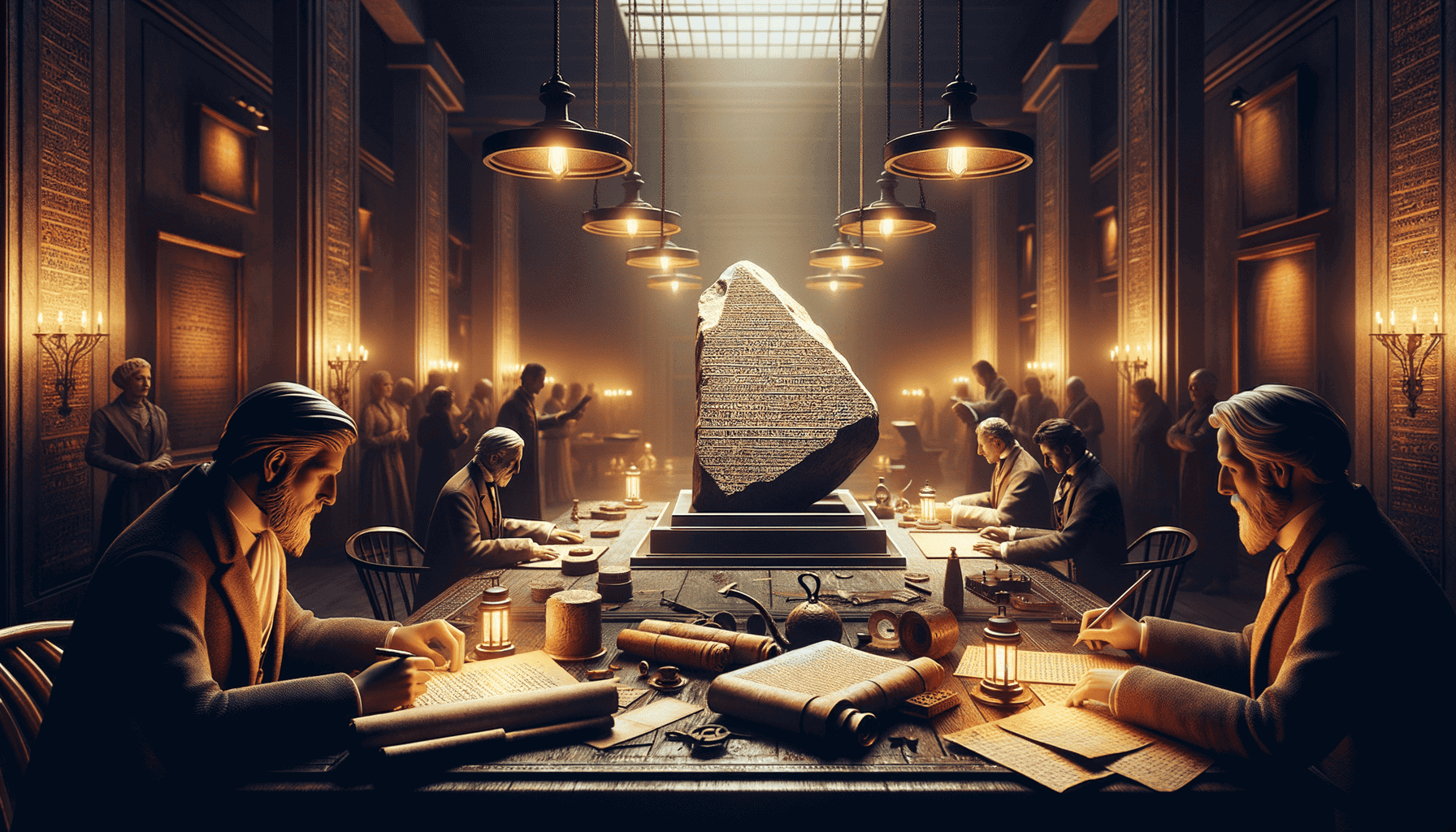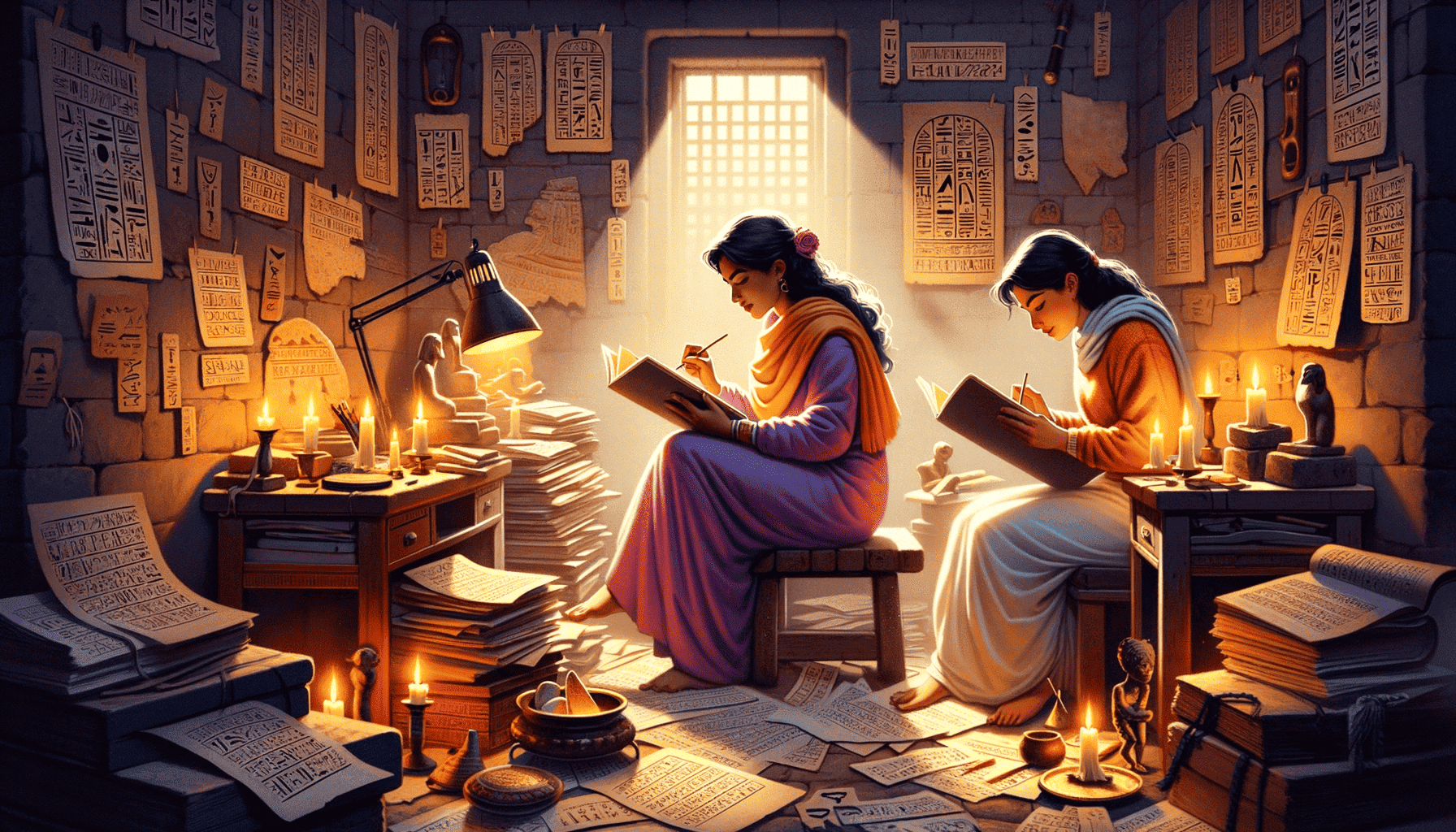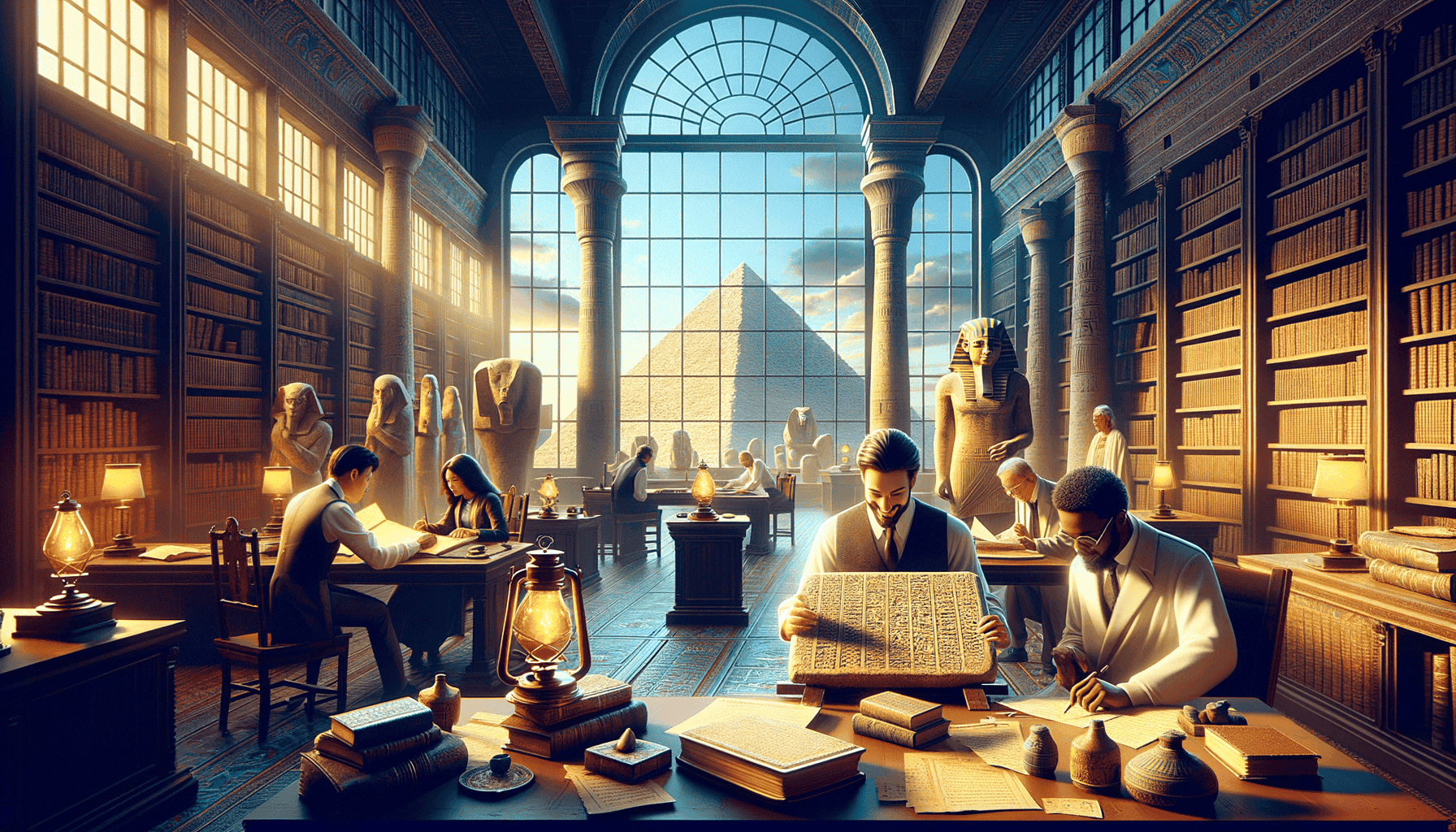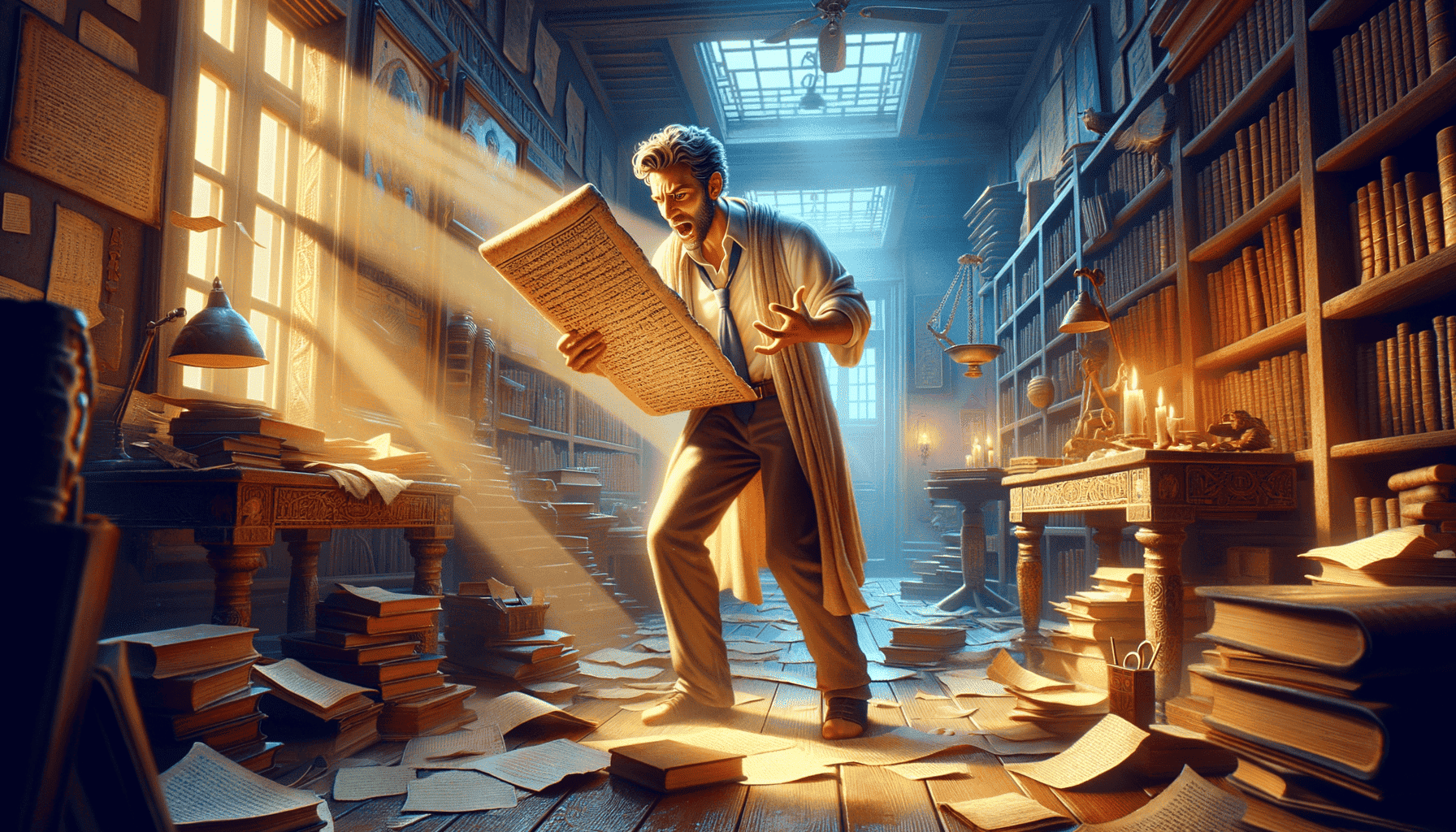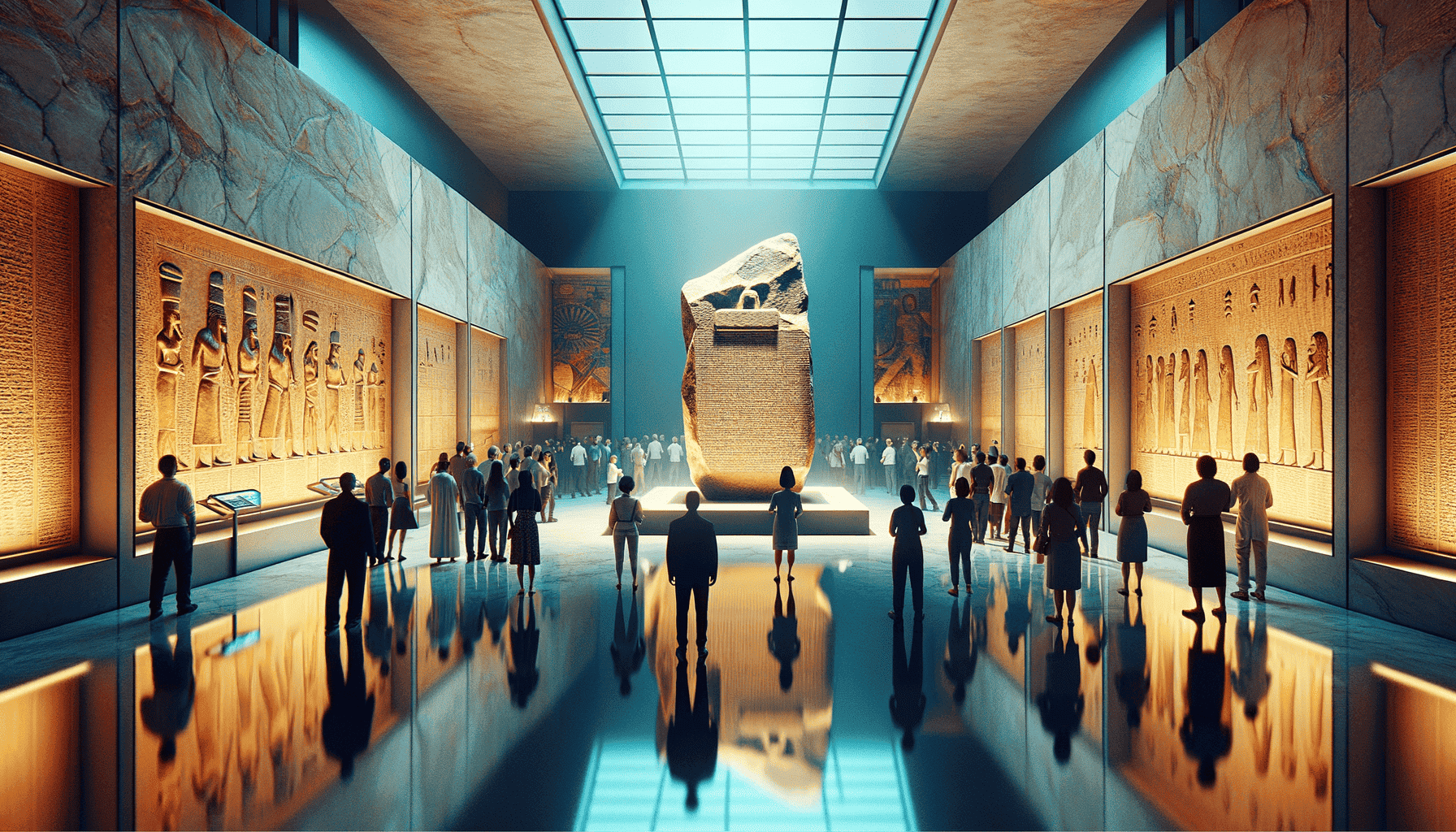A Stone in the Sand
The hot Egyptian sun beat down on Pierre François-Xavier Bouchard as he watched his soldiers dig in the sandy soil. It was 1799, and they were building a fort near the town of Rashid. The air was thick with dust, making it hard to breathe.
"Lieutenant!" a young soldier called out, his voice shaking with excitement. "We found something!"
Bouchard rushed over, his boots sinking into the soft sand. There, partially buried in the earth, was a large dark stone with strange markings all over it.
"Careful now," Bouchard ordered, wiping sweat from his brow. "This could be important."
The Discovery
The soldiers worked slowly, using their hands to clear away the sand. As more of the stone appeared, Bouchard's heart began to race. The stone was huge – as tall as a grown man and as wide as a door. But what made it truly special were the strange symbols carved into its surface.
"Look here, sir," said Ahmed, one of the local workers, pointing to the markings. "These are the words of our ancestors."
Bouchard nodded, studying the stone carefully. There were three different types of writing:
• Top section: Ancient Egyptian hieroglyphs
• Middle section: Another type of Egyptian writing
• Bottom section: Greek letters they could read
A Race Against Time
"We must get this stone to safety," Bouchard declared. "It could help us understand the ancient writing of Egypt!"
The soldiers worked together, using ropes and wooden planks to carefully lift the stone. It was like trying to move a sleeping elephant – heavy and dangerous if they made a mistake.
"Slowly… slowly…" Bouchard called out, directing the men. Every inch was a struggle against the stone's massive weight.
The First Night
As the sun set over the Nile Delta, Bouchard sat in his tent writing a letter to his commanders. This could be the key to understanding ancient Egypt, he thought, his quill scratching against the paper.
Outside, two guards stood watch over the stone. In the flickering torchlight, the ancient symbols seemed to dance and come alive.
"What secrets do you hold?" Bouchard whispered, touching the cool surface of the stone. He didn't know it yet, but he had just found one of the most important archaeological discoveries in history. This mysterious stone would soon be known as the Rosetta Stone, and it would change how we understand the past forever.
That night, as the desert winds howled outside his tent, Bouchard dreamed of ancient pharaohs and forgotten languages. The stone had started its journey from being buried treasure to becoming a key that would unlock the secrets of ancient Egypt.
The guards whispered stories through the night, wondering what magic might be locked within the stone's mysterious symbols. Little did they know, scholars would spend the next twenty years trying to solve its puzzle.
As dawn approached, Bouchard made plans to transport the stone to Cairo. This was just the beginning of an amazing adventure that would connect the modern world to the secrets of ancient Egypt.
A Tale of Two Scholars
The morning sun streamed through the tall windows of the British Museum. Thomas Young hunched over his desk, studying drawings of the strange stone from Egypt. His fingers traced the careful copies of the three different types of writing.
The First Clues
“These marks must mean something,” Young muttered, adjusting his round glasses. He had been working on this puzzle for months. The stone showed the same message in three different ways:
• Ancient Egyptian hieroglyphs (picture writing)
• Demotic (everyday Egyptian writing)
• Greek (which scholars could read!)
Across the English Channel in Paris, a young French scholar named Jean-François Champollion was also studying the stone. At just 25 years old, his desk was piled high with papers covered in drawings of birds, snakes, and other hieroglyphs.
The Great Race Begins
“Mon Dieu!” Champollion exclaimed, jumping from his chair. “Each picture must stand for a sound, not just an idea!”
Both men worked day and night. It was like trying to solve the biggest puzzle in the world. Young figured out that some hieroglyphs spelled out names, while Champollion discovered that the pictures could write words like our ABC’s.
Friends or Rivals?
Letters flew back and forth between London and Paris. Sometimes the scholars shared their ideas, but sometimes they kept their best discoveries secret.
“Have you seen Young’s latest paper?” asked Champollion’s friend.
“Oui, but I think he is missing something important,” Champollion replied, his eyes bright with excitement. “The hieroglyphs are more than just simple pictures!”
The Stone’s Secrets
Young picked up a quill and wrote carefully in his notebook. The stone was like a giant dictionary, helping them understand the mysterious hieroglyphs. But it was also damaged – parts of it were broken off and lost.
Champollion drew picture after picture, making lists of hieroglyphs and their meanings. His sister helped him organize his notes, which covered every surface of his small room.
A Growing Understanding
As the months passed, both scholars made progress. Young discovered that some hieroglyphs stood for sounds, like our letters. But he thought most of them were still just pictures.
Champollion went further. He realized that nearly all hieroglyphs could be used to spell words, just like our alphabet. It was a huge breakthrough!
Late one night, Young looked at his work and sighed. “Perhaps young Champollion is onto something after all,” he mumbled, reaching for another sheet of paper.
Meanwhile, in Paris, Champollion could barely sleep. He knew he was getting closer to cracking the code that had stayed secret for almost 2,000 years. His dream of reading the ancient Egyptian words was almost real.
The stone’s mystery was slowly being solved, but the biggest breakthrough was still to come. As Young and Champollion worked in their separate cities, they didn’t know that they were both part of one of the greatest detective stories in history.
Breaking the Ancient Code
The candlelight flickered across Champollion’s desk as he worked late into the night. His fingers were stained with ink, and papers covered in hieroglyphs were scattered everywhere. ️
A Midnight Discovery
“Eureka!” Champollion shouted, jumping from his chair. He had just made an amazing discovery about how the ancient Egyptians wrote names.
His sister Zoé rushed into the room. “What is it, François?”
“Look here,” he pointed excitedly. “These symbols in a special oval shape – they spell out royal names!” ✨
• Royal names were written in special ovals called cartouches
• Each picture stood for a sound, like our alphabet
• He could now read names like “Ptolemy” and “Cleopatra”
Racing Against Time
Back in London, Thomas Young received news of Champollion’s progress. His hands trembled as he read the letter.
“He’s moving too fast,” Young muttered, reaching for his own notes. “I must work harder!”
But Champollion was on fire with excitement. Every day brought new understanding. He barely ate or slept, focusing only on the ancient writing.
Solving the Puzzle
Champollion spread his work across the floor. Hundreds of symbols were now making sense. Birds, snakes, and simple lines all had special sounds.
“It’s like music,” he told Zoé. “Each picture sings its own note, and together they make words!”
The Big Test
One morning, Champollion got a package. Inside were copies of hieroglyphs from other Egyptian temples – ones not on the Rosetta Stone!
His hands shook as he unfolded the papers. “If I’m right,” he whispered, “I should be able to read these too.”
Hour after hour, he worked at translating. Slowly, the ancient words came to life. He was reading messages that had been silent for 2,000 years!
Victory and Rivalry
News of Champollion’s success spread quickly. Some scholars were happy, but others were jealous. Young felt especially upset.
“How can this young Frenchman claim all the credit?” Young complained to his friends. “I made important discoveries too!”
Sharing the Secret
Champollion worked fast to write down everything he had learned. He wanted to teach others how to read hieroglyphs too.
“The ancient Egyptians have so many stories to tell us,” he said during a big speech in Paris. “Now we can finally hear them!”
Young eventually accepted that Champollion had solved the biggest part of the puzzle. He wrote a letter saying, “The young man has done what I could not.”
Secrets of the Ancient World
The morning sun streamed through tall windows as Champollion paced in his study. His new understanding of hieroglyphs was opening doors to an amazing world.
Ancient Stories Come Alive
“Listen to this, Zoé!” Champollion called to his sister. “These symbols tell about Egyptian kings and their mighty temples!”
He pointed to a drawing showing tall buildings and people in fancy clothes. “The ancient Egyptians lived very different lives than we do.”
• They built huge temples to their gods
• Pharaohs were like kings and queens
• People wrote stories on walls and paper made from plants
• They had doctors, teachers, and artists
Two Worlds Meet
In Egypt, local scholars watched the European excitement with mixed feelings.
“Our grandfathers knew these places were special,” said Hassan, an Egyptian teacher. “But now the whole world wants to learn our history.”
More researchers came to Egypt, drawing pictures of everything they saw. They filled notebooks with copies of ancient writing.
Learning from the Past
Every new translation brought surprises. The ancient Egyptians knew many things about math, stars, and medicine.
“They were so smart!” Champollion told his students. “They could build huge pyramids and heal sick people.”
Bridging Time
Back in Paris, people crowded museums to see Egyptian treasures. Children pressed their faces against glass cases, wondering about the people who made these things.
“Can you read what it says?” they asked Champollion, pointing at hieroglyphs.
He smiled and began to translate, watching their eyes grow wide with wonder.
Working Together
European and Egyptian scholars started sharing their knowledge. Each group had pieces of the puzzle.
“Your ancient stories match our old tales,” said Ahmed, an Egyptian helper. “Perhaps we’re not so different after all.”
A Growing Understanding
As more hieroglyphs were read, bigger patterns emerged. The ancient Egyptians had rules, jobs, and families just like people today.
“They wrote love poems!” Champollion announced one day. “And funny stories about clever animals!”
Young sent a kind note from London: “Perhaps we needed everyone’s help to unlock these mysteries.”
The Final Breakthrough
Champollion couldn’t sleep. His desk was covered with papers full of hieroglyphs. The answer was so close!
A Morning Surprise
The sun was barely up when Champollion jumped from his chair. “I’ve got it!” he shouted. His sister Zoé ran into the room.
“Look here!” He pointed to his notes with shaking hands. “These pictures don’t just stand for things – they make sounds too!”
• Some hieroglyphs were like letters
• Others showed whole words
• Pictures could mean different things
• The writing told stories like we do today
Racing to Tell the World
Champollion ran through the streets of Paris in his pajamas! ♂️ He burst into the Academy of Sciences, where important scholars worked.
“I can read it!” he cried. “I can read ancient Egyptian!”
The room went quiet. Then everyone started talking at once.
Reading Ancient Words
“This part talks about King Ptolemy,” Champollion explained. “And here it tells about gifts to the temples.”
The old stones were speaking again after 2,000 years of silence! ️
“It’s like magic,” whispered a young student. “The ancient Egyptians are talking to us!”
Happy News Spreads
Letters flew between Paris and Egypt. Even Thomas Young in London sent congratulations.
“You’ve done what we all dreamed of,” Young wrote. “Now we can learn so much more!”
A New Beginning
People wanted to learn everything about ancient Egypt. Museums opened their doors wide. Students came from everywhere to study with Champollion.
“This is just the start,” he told them. “There are so many more stories to read!”
Dreams Come True
At last, Champollion visited Egypt himself. He touched the walls he had dreamed about for so long.
“Hello, old friends,” he said to the hieroglyphs. “I’ve waited many years to meet you.”
Egyptian scholars welcomed him warmly. Together, they read the ancient words aloud.
The Past Speaks Again
The Rosetta Stone changed everything! Now museums across the world wanted to learn what their Egyptian treasures said. ️
New Adventures Begin
Young students rushed to join Champollion’s classes. “Show us how to read the ancient words!” they begged.
“Every picture tells a story,” Champollion smiled. “Let me show you how.”
• How pyramids were built
• What kings and queens did
• Stories about Egyptian gods
• How people lived long ago
Treasures Around the World
The British Museum proudly showed off the Rosetta Stone. People came from everywhere to see it!
“This stone helped us understand a whole lost world,” the museum guide explained.
“It’s like having a magic key that opens doors to the past,” said a young visitor.
Egypt Wakes Up
In Egypt, people felt proud. Their ancestors had made something amazing!
“Our great-great-grandparents were so clever,” said an Egyptian teacher. “They left us messages that lasted thousands of years.”
A Bridge Between Times
Thomas Young and Champollion showed us something important: working together makes big dreams come true!
“Knowledge is like a torch,” Champollion wrote. “When we share it, it grows brighter.”
Never-Ending Story
Today, new things about ancient Egypt are still being found!
Scientists use computers to read faded writing. Archaeologists dig up new treasures. Students learn to write their names in hieroglyphs.
The Story Lives On
The Rosetta Stone reminds us that mysteries can be solved when we try hard and work together.
“What will you discover?” Champollion asked his students. Now we ask the same question.


